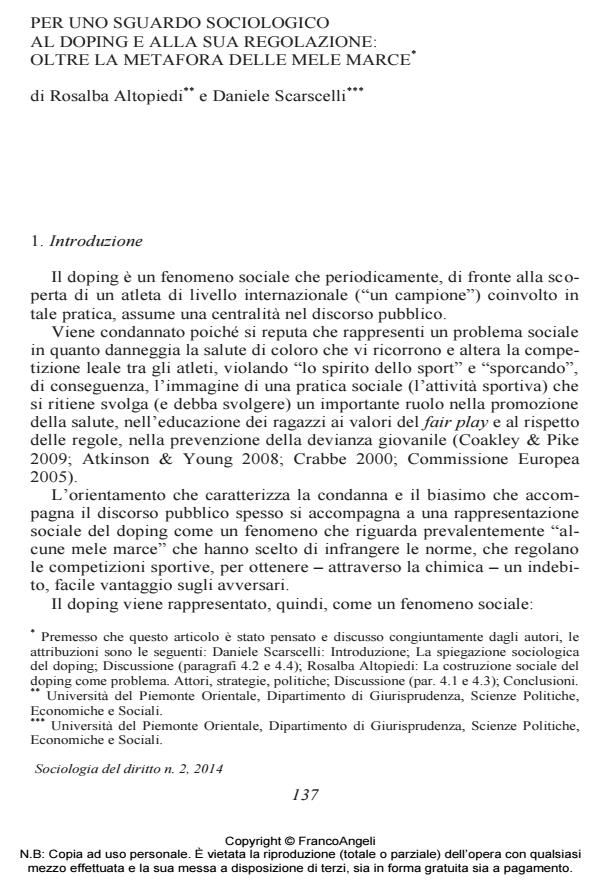Towards a sociological approach to doping and its regulation: overcoming the metaphor of the rotten apples
Journal title SOCIOLOGIA DEL DIRITTO
Author/s Rosalba Altopiedi, Daniele Scarscelli
Publishing Year 2015 Issue 2014/2
Language Italian Pages 34 P. 137-165 File size 193 KB
DOI 10.3280/SD2014-002006
DOI is like a bar code for intellectual property: to have more infomation
click here
Below, you can see the article first page
If you want to buy this article in PDF format, you can do it, following the instructions to buy download credits

FrancoAngeli is member of Publishers International Linking Association, Inc (PILA), a not-for-profit association which run the CrossRef service enabling links to and from online scholarly content.
Doping is a social phenomenon that looms large in public discourse periodically, whenever an internationally ranking athlete (a champion") is discovered to have been involved in the practice. Doping is roundly condemned for constituting a social problem, since it harms the health of those who make use of it and derails the loyalty of competition between athletes, so violating the "spirit of sport". The orientation typical of this condemnation and the blame that accompanies the public discourse is often based on a social representation of doping as a phenomenon that is primarily restricted to a "handful of rotten apples". In actual fact, however, sociological literature in the last two decades has furnished ample empirical evidence that enables us to state that doping is not concerned with just that "handful of rotten apples", but is a social phenomenon that has spread from élite to amateur sports, as well as to the gyms and fitness centres. This article aims to present the various different sociological explanations of doping and to describe the forms of regulation of the phenomenon that have gradually been institutionalised over the years, identifying the models of the phenomenon’s explanation that underlie - often implicitly - the main policies of prevention and control and highlighting certain critical questions posed by these forms of regulation in terms of safeguarding health, rights and civil liberties, as well as of the real effectiveness of controls.
Keywords: Sociology of Sport - Doping - ‘Rotten Apples’ Approach - Prevention - Deterrence
- Come si diventa dopati Rosalba Altopiedi, Daniele Scarscelli, in Sociologia del diritto /2023
DOI: 10.54103/1972-5760/20578
Rosalba Altopiedi, Daniele Scarscelli, Per uno sguardo sociologico al doping e alla sua regolazione: oltre la metafora delle mele marce in "SOCIOLOGIA DEL DIRITTO " 2/2014, pp 137-165, DOI: 10.3280/SD2014-002006